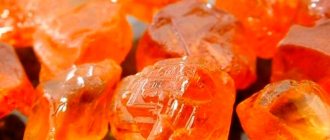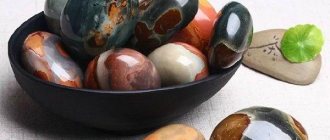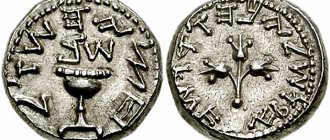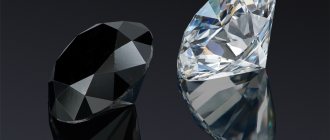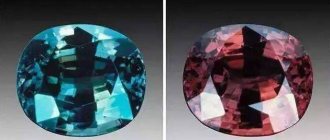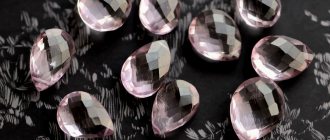Why are such gems valued?
Green stones enjoy well-deserved respect:
- This color is considered the embodiment of natural harmony; its contemplation suppresses negative emotions, bringing peace;
- Bright green color inspires optimism, cheerfulness and confidence;
- Green color symbolizes peace and security.
For many people, green stones are primarily a money talisman. Bankers, financiers or people who want to get rich carry jewelry with them.
Description of green minerals
There are many natural green stones. They are found underground, in caves, near volcanoes, in mountains, and in places where iron ores are formed. This changes the chemical formula, physical properties and shade.
All minerals are divided into 3 groups:
- Gems. Transparent, have optical effects. They have a hardness of 8 to 10. They are extremely rare and expensive.
- Semi-precious minerals. More common. These include both transparent and translucent specimens. Hardness varies between 6–8. Some have optical effects.
- Ornamental stones. Distributed and mined everywhere. They have a relatively low cost. They are not transparent and have no optical effect. Hardness is lower than previous types.
Artificial gems are included in a separate group.
They also belong to stones, but are grown in laboratory conditions. Minerals can have a variety of shades, from rich emerald to light, almost transparent. Some of them acquire a greenish tint only under certain conditions.
Green gemstones
There are few green precious stones. They are used to create jewelry and are framed in platinum or gold. Often the price of gems reaches thousands of dollars per carat:
- Emerald. A rare gemstone that belongs to beryl. It is distinguished by its rich dark green color, transparency, and ability to refract light. The color is due to the chromium or vanadium content.
- Chlorosapphire. Precious green sapphires are even rarer than emeralds. It is a transparent stone of a rich hue, usually with a bluish or yellow tint. The color is obtained due to the presence of divalent and trivalent iron in the structure.
- Alexandrite. Belongs to chrysoberyls. The color changes depending on the lighting. In natural light, the stone has a greenish color, and in artificial light it takes on a purple or red tint. The green spectrum of the gem is due to the chromium content.
- Green diamond. One of the rarest varieties of diamond. There are specimens with colors of varying saturation (from light, almost colorless, to bright green). The greenish color occurs due to the presence of nitrogen atoms in the structure or irradiation of nuggets with uranium and thorium. It has a diamond shine and a high degree of light refraction.
Precious stones are given a faceted or multi-stage shape. This helps to better highlight their shine, color and optical effects.
Semi-precious
Semi-precious stones are also used to make jewelry. They are found in insufficient quantities to be used for industrial purposes. The cost of minerals is quite high. The price of some of them is not inferior to precious gems.
- Tsavorite. One of the rarest species, the beauty of which was first appreciated by. The color range varies from light greenish to dark blue-green. Refers to grenades. The only deposit of transparent stone is Africa. Opened relatively recently.
- Chrysolite. Refers to olivines. The mineral is yellow-green or grassy in color. Jewelry varieties are completely transparent.
- Beryl. It has a less saturated color than emerald. Reminds me of bottle glass. This is a transparent stone, the hue of which arises from the ferrous iron in its composition.
- Chrysoberyl. Transparent or translucent mineral of high value. There are yellow-green and olive specimens. Some of the stones have a special structure that gives them the ability to reflect. Such gems are called cat's eyes.
- Demantoid. A rare variety of pomegranate. It has an emerald color and diamond shine. There is a question about including a gem in the group of precious stones.
- Uvarovite. Herbaceous green mineral. Formed in small crystals with a strong shine on other black minerals. When making jewelry, the stone is not cut, but is used in its natural form together with black rock, which is hidden under the frame.
- Verdelite. Marsh or olive tourmaline. Has a strong shine.
- Moldavite. Emerald natural glass of quartz origin. A rare mineral discovered in the Czech Republic. Scientists believe that it either fell to Earth with a comet, or was formed due to the melting of the earth's rock under the influence of a falling meteorite.
- Chrome tourmaline. Transparent or cloudy stone of dark green color. Reminds me of an emerald. The only deposit is located in Tanzania. Minerals weighing 1 carat are more often mined. Larger gems have a high price and are put up at auctions.
- Chrysoprase. A rare mineral of pale or apple green color.
- Chrome diopside. Transparent or translucent gem with high reflectivity. There are bright green and yellow-green specimens. Rare star gems are especially prized.
- Enstatite. An absolutely transparent mineral of a grassy or gray-green hue. Has the ability to pleochroism. Shimmers in bronze, brown, yellow and brown colors.
- Giddenite. Transparent subspecies of spodumene. It comes in olive, bottle and emerald shades. Depending on the lighting, it shimmers in different tones.
- Idocraz. Transparent specimens are prized. This is an olive or green-blue stone.
- Cornerupin. Transparent stone of marsh, brown-green or yellowish color. Possesses pleochroism. Shimmers in brown, green, yellow and red hues.
- Opal. A popular variety of greenish-blue gems. Shimmers with pink, blue, green, purple shades.
- Sphen. Light transparent gems. They have a higher light scattering ability than diamond and a pleochroism effect. Valued by jewelers, but rarely seen.
- Sultanite. Rare, expensive and beautiful stone. Absolutely transparent. Changes color: in daylight it is bright green or golden, in lamplight it becomes beige-yellow, a candle flame makes it pink.
Ornamental
Ornamental stones are common and inexpensive. They are used to make jewelry, figurines, and interior items. Some are used as a finishing material in other industries:
- Jade is a Chinese green stone. Consists of thin amphibole fibers. Viscous and durable rock. There are nuggets of all shades of green. Typically, opaque or translucent gems have a pattern of white dots and black veins.
- Jade. A translucent or opaque mineral of bright green color. Each nugget combines spots, stripes and inclusions of gray, white, greenish and emerald shades.
- Malachite. Opaque, matte mineral before polishing. One stone combines turquoise, emerald and light green shades. The breed is characterized by a ring or patterned pattern.
- Serpentinite, or serpentine. A soft marsh-colored mineral with a pattern reminiscent of reptile skin. Easy to process.
- Amazonite. Turquoise or greenish gems. There is often a white pattern present.
- Quartz with cat's eye effect. This inexpensive mineral has a greenish-gray tint. Thanks to the special structure, after cutting in the form of a cabochon or bead, a light highlight appears on the gem.
- Actinolite. Matte or translucent yellow-green gem, covered with stains of various shades. Has a strong glass luster.
- Green agate. Found in nature, the rock resembles an ordinary matte gray cobblestone. The beauty of the mineral is noticeable when cut. The gem has a bright green hue and an unusual pattern that can resemble trees, water, mountains or sand dunes.
- Apatite. A translucent, less often transparent, marsh-colored mineral. Quite solid. Has a glassy sheen.
- Aventurine. A gem that combines yellow and greenish shades. It often has a glowing effect due to hematite inclusions scattered in the form of sparkles in the structure of the stone.
- Bloody stone. The gem is gray-green in color with blood-red streaks and a pattern reminiscent of moss. Refers to chalcedony. Has high hardness.
- Mau-sit-sit. A rare emerald-colored ornamental mineral with beautiful black and yellow streaks. It is mined only in Burma.
Artificial stones
Scientists have learned to grow stones with a green color. To do this, create conditions similar to those in which minerals are formed in nature. The basis is taken from natural mineral powder.
Scientists give some yellow or transparent gems a greenish color in the laboratory. To do this, they are irradiated in special devices or bombarded with atoms that change the shade of minerals (chromium, nitrogen).
Artificial stones are not considered fake. Their cost is much lower than natural specimens.
Artificial
Green varieties of minerals are often mined separately. Therefore, people have learned to produce them by heat treatment or irradiation. An artificial mineral is not considered a fake because its texture remains natural. Often manufacturers do not hide the origin of the stone.
For example, the Kaliningrad Amber Plant produces jewelry imitations of green amber - bernite and buranite. These are natural raw materials combined with natural resins.
The most famous examples are cubic zirconia and moissanite. A product of technology, an analogue of diamonds, recognized only with the help of specialized equipment.
Green cubic zirconia
Magic properties
According to the zodiac, green stones are more suitable for representatives of the Earth and Fire triad.
The properties of green minerals are beneficial for people: stones prevent spontaneous, hasty actions or words. They bring peace and harmony to everyday life.
In addition, each green stone is individually useful:
- Green diamond harmonizes family relationships. It is a talisman for pregnant women and protects the unborn child.
- Emerald is a protector against dark forces and helps to find and maintain love or family ties.
- Green sapphire is an attribute of businessmen and creative people. The first will ensure financial success, the second will help you find yourself and unlock your potential.
- Jewelry with peridot is worn when a person is overcome by depression or when the strength of spirit weakens.
- It also protects against corruption, the evil eye and physical aggression.
- Green garnets help when luck or prosperity is lacking.
- Alien forms are used to cleanse the aura or develop intuition.
- Beads or necklaces made of green onyx are the key to family well-being.
Bankers, financiers, gamblers and people with an adventurous streak consider money-colored stones to be their talismans.
Agate
This striped stone with unique wavy patterns is classified as semi-precious. It is believed that if you look at it for a long time, you can see beautiful landscapes. According to legend, agate was one of the first stones from which decorative items and jewelry were made. The gem received its name thanks to the Achates River, on the banks of which it was first found.
In total, agate has about 150 varieties. But the most common of them is Brazilian. Its distinctive feature is the presence of natural inclusions. In addition to it, moss, Uruguayan, magic and landscape types of stone are popular.
Our ancestors believed that those who carry this mineral with them are under God's protection. The gem brings people positive emotions and makes them more sociable and lucky. The stone protects its owner from evil forces and is considered a symbol of longevity and prosperity. There is an opinion that an agate given to a loved one will become the most powerful amulet for him.
The healing properties of the stone include: the ability to treat pathologies of the throat and liver, and strengthen the immune system. To do this, it is recommended to wear it in the form of a bracelet. Periodically, the agate should be washed with cold water. This way, all the negative energy that the mineral retained is removed from its surface.
This stone is suitable for Gemini and Taurus. But for Aries and Sagittarius it will be useless.
Therapeutic effect
The influence of green stones on humans is extremely positive:
- People have noticed that just looking at the lush greenery of a tree for a while is enough to rest your eyes and improve your mood.
- Yogis have established a connection between the green hue and the heart chakra. It heals mental wounds, normalizes heart rate and blood pressure. Headaches, including migraines, subside.
- Lithotherapists supplemented these observations by expanding the meaning of these minerals. For example, they have been found to protect against radiation.
Natural green stones strengthen the body as a whole, activating its reserves. The body works like a clock. Contemplating them improves vision.
Opaque minerals are considered particularly powerful healers.
Decorations
Stones of this variety are inserted into jewelry taking into account the jewelry value and shade of inlay:
- bright yellow or white gold, platinum is suitable for transparent gemstones of deep green color;
- semi-precious stones go well with sterling silver;
- precious stones are set in cupronickel;
- Artificial stones (except cubic zirconium and moissanite) are costume jewelry made of jewelry alloy or medical steel.
The wearing “code” is similar to other colored minerals: the older the wearer, the larger and darker the inlay.
Green colors are effective in sets: earrings plus a ring/necklace/bracelet; cufflinks plus a tie pin.
However, don't go overboard with the size of the inlay. A brooch, ring, pendant or bracelet with large sparkling stones can look vulgar. Especially jewelry with artificial precious stones.
Why do you dream of green stones?
Dreamers associate this range with everyday things. If you dreamed of green stones, success in business, profit, a successful marriage is just around the corner:
- Miller. If you found a large shiny stone in a dream, in reality expect success in personal business projects and wealth in general.
- Vanga. If you dreamed that you found a gem, you will get new opportunities in your personal and professional life.
- Tsvetkov. Such stones in your dream portend super-success in business or risky projects. We cannot rule out pleasant surprises in other areas.
- Chinese book of dreams. Seeing such stones in a dream means no physical health problems in the near future. Such a dream is an especially good sign for sick people: the disease will not persist.
A separate interpretation is the dream of jewelry with green stones:
- You received gold earrings, a pendant, a brooch or other jewelry with such an insert (especially a ring) - expect a marriage proposal soon. Don't reject him: the marriage will be successful.
- The loss of jewelry with a stone foreshadows a quarrel or disagreement with your “other half.”
- Wearing a ring with a green stone means that you will receive a promotion at work or a career in business. Or otherwise elevate yourself above your environment. You may receive an inheritance, which may cause tension in the family.
- A ring or signet with such a stone on the finger speaks of unexpected, stable profits.
- If you find a ring and it turns out to be small, think about the relationship: it is outdated.
If the stone in your jewelry turns out to be fake, be careful. Perhaps disappointment in a business partner, children or spouse.
Chrysoprase
Since ancient times, this stone has represented power and wealth. It combines well with other minerals. Its main value lies in its ability to protect its owner from people with evil intentions. Healers used it to treat colds, strengthen blood vessels and improve brain function. To do this, water was infused on the stone, which was then taken orally. Chrysoprase is considered the talisman of Aquarius. He will help him achieve high goals. Virgos, Sagittarius and Gemini will be charged with positive energy from it.
